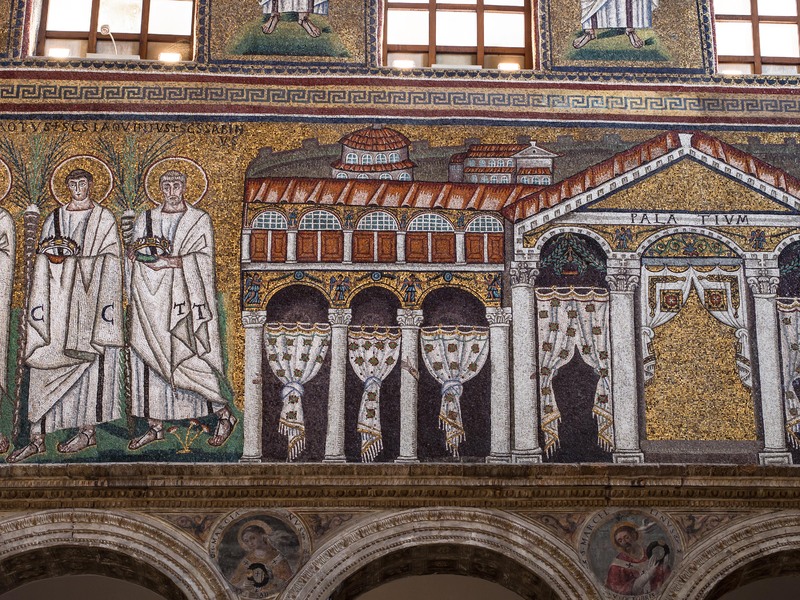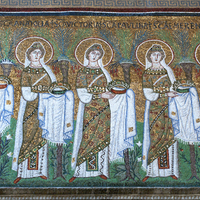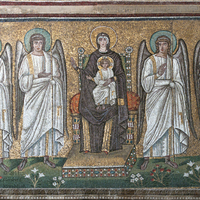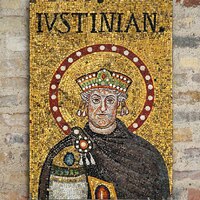Church of Sant'Apollinare Nuovo
Date:
Sixth century
Location or Findspot (Modern-Day Country):
Italy
Description:
Sant'Apollinare Nuovo is a basilica with a wide nave flanked on either side by an aisle and terminating in an apse. The acanthus leaf capitals may have been imported from Constantinople, and the mosaics show a great deal of Byzantine influence. It was consecrated twice: once in 504 as an Arian church and then again in 561, under Justinian I (r. 527–65), at which point the explicitly Arian images were removed (Arianism was a non-trinitarian form of Christianity and therefore considered heretical). The basilica was dedicated to St. Apollinaris in the ninth century, possibly when the saint's relics were translated there.
It was originally built as the palace church of Theoderic (r. 489–526), the Ostrogothic king who was raised at the Byzantine court in Constantinople. Ravenna was his capital city and the center of the Ostrogothic kingdom of Italy. Theoderic intended his building projects and adaptation of Byzantine imperial style to convey his role as Roman emperor. Under his patronage, Ravenna became an important center of mosaic art.
The nave mosaics are in three tiers. In the lowest tier are figures in processions added at the time of Bishop Agnellus (r. 556–69): male martyrs on the south side head towards Christ enthroned, and female martyrs on the north head towards the Virgin and Child adored by the Magi. An image of Justinian I, now fragmentary, shows him older than in his "portrait" at San Vitale. In the second tier (at the level of the windows) are figures of apostles and prophets standing below votive crowns. In the highest tier are biblical narrative scenes from the life of Christ. Representations of three-dimensionality are diminished. The focus, instead, is on spiritual abstraction, a feature enhanced by gold backgrounds in this and other local mosaic representation. There are still remains of the mosaics that once depicted Theoderic and members of his court in the palace. Their hands and arms in gestures of prayer are still visible on some of the mosaic columns.
It was originally built as the palace church of Theoderic (r. 489–526), the Ostrogothic king who was raised at the Byzantine court in Constantinople. Ravenna was his capital city and the center of the Ostrogothic kingdom of Italy. Theoderic intended his building projects and adaptation of Byzantine imperial style to convey his role as Roman emperor. Under his patronage, Ravenna became an important center of mosaic art.
The nave mosaics are in three tiers. In the lowest tier are figures in processions added at the time of Bishop Agnellus (r. 556–69): male martyrs on the south side head towards Christ enthroned, and female martyrs on the north head towards the Virgin and Child adored by the Magi. An image of Justinian I, now fragmentary, shows him older than in his "portrait" at San Vitale. In the second tier (at the level of the windows) are figures of apostles and prophets standing below votive crowns. In the highest tier are biblical narrative scenes from the life of Christ. Representations of three-dimensionality are diminished. The focus, instead, is on spiritual abstraction, a feature enhanced by gold backgrounds in this and other local mosaic representation. There are still remains of the mosaics that once depicted Theoderic and members of his court in the palace. Their hands and arms in gestures of prayer are still visible on some of the mosaic columns.
Relevant Textbook Chapter(s):
3
Repository and Online Resources:
• For image galleries and video footage of the interior, visit the website of the Opera di Religione della Diocesi di Ravenna.
• Visit the UNESCO World Heritage page for the early Christian monuments of Ravenna.
Image Credits:
Genevra Kornbluth, Wikimedia Commons, flickr







